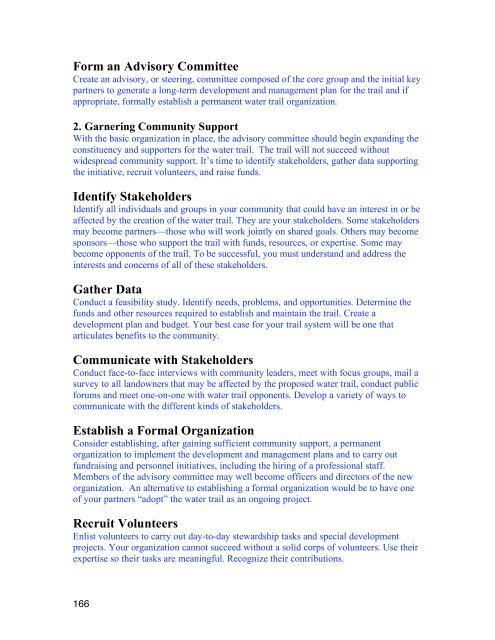Draft Interpretive Plan Join the adventure! - Captain John Smith ...
Draft Interpretive Plan Join the adventure! - Captain John Smith ...
Draft Interpretive Plan Join the adventure! - Captain John Smith ...
You also want an ePaper? Increase the reach of your titles
YUMPU automatically turns print PDFs into web optimized ePapers that Google loves.
Form an Advisory Committee<br />
Create an advisory, or steering, committee composed of <strong>the</strong> core group and <strong>the</strong> initial key<br />
partners to generate a long-term development and management plan for <strong>the</strong> trail and if<br />
appropriate, formally establish a permanent water trail organization.<br />
2. Garnering Community Support<br />
With <strong>the</strong> basic organization in place, <strong>the</strong> advisory committee should begin expanding <strong>the</strong><br />
constituency and supporters for <strong>the</strong> water trail. The trail will not succeed without<br />
widespread community support. It’s time to identify stakeholders, ga<strong>the</strong>r data supporting<br />
<strong>the</strong> initiative, recruit volunteers, and raise funds.<br />
Identify Stakeholders<br />
Identify all individuals and groups in your community that could have an interest in or be<br />
affected by <strong>the</strong> creation of <strong>the</strong> water trail. They are your stakeholders. Some stakeholders<br />
may become partners—those who will work jointly on shared goals. O<strong>the</strong>rs may become<br />
sponsors—those who support <strong>the</strong> trail with funds, resources, or expertise. Some may<br />
become opponents of <strong>the</strong> trail. To be successful, you must understand and address <strong>the</strong><br />
interests and concerns of all of <strong>the</strong>se stakeholders.<br />
Ga<strong>the</strong>r Data<br />
Conduct a feasibility study. Identify needs, problems, and opportunities. Determine <strong>the</strong><br />
funds and o<strong>the</strong>r resources required to establish and maintain <strong>the</strong> trail. Create a<br />
development plan and budget. Your best case for your trail system will be one that<br />
articulates benefits to <strong>the</strong> community.<br />
Communicate with Stakeholders<br />
Conduct face-to-face interviews with community leaders, meet with focus groups, mail a<br />
survey to all landowners that may be affected by <strong>the</strong> proposed water trail, conduct public<br />
forums and meet one-on-one with water trail opponents. Develop a variety of ways to<br />
communicate with <strong>the</strong> different kinds of stakeholders.<br />
Establish a Formal Organization<br />
Consider establishing, after gaining sufficient community support, a permanent<br />
organization to implement <strong>the</strong> development and management plans and to carry out<br />
fundraising and personnel initiatives, including <strong>the</strong> hiring of a professional staff.<br />
Members of <strong>the</strong> advisory committee may well become officers and directors of <strong>the</strong> new<br />
organization. An alternative to establishing a formal organization would be to have one<br />
of your partners “adopt” <strong>the</strong> water trail as an ongoing project.<br />
Recruit Volunteers<br />
Enlist volunteers to carry out day-to-day stewardship tasks and special development<br />
projects. Your organization cannot succeed without a solid corps of volunteers. Use <strong>the</strong>ir<br />
expertise so <strong>the</strong>ir tasks are meaningful. Recognize <strong>the</strong>ir contributions.<br />
166








